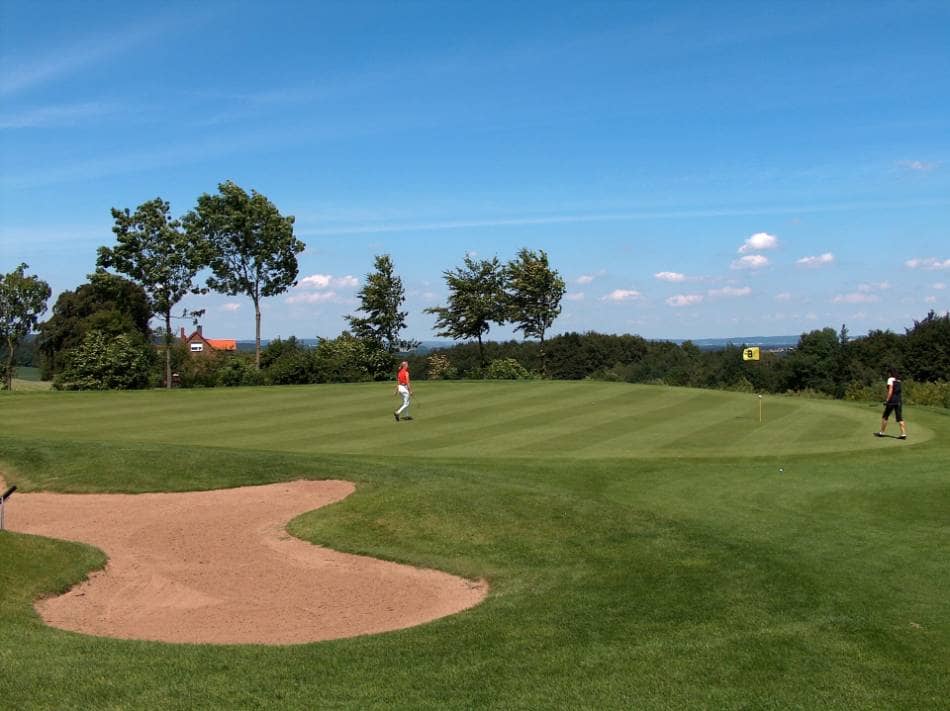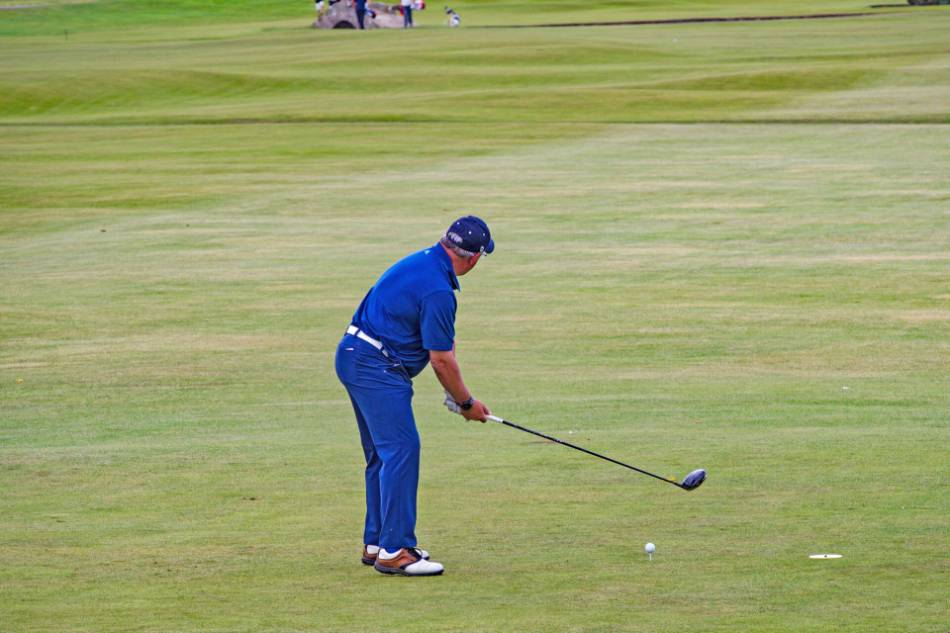
People who are acclimated with golf will tell you that par is supposed to be based on the average number of strokes to complete a hole. Those same people will tell you from observing other players that most weekend warrior golfers do not make par on every hole they play.
So, what is an average golf score?
An average golf score for 18 holes is 100, assuming that all the rules of golf are followed. The average handicap index, kept by the GHIN system, is a 16.1 for men and a 28.9 for women. If you’re a bogey golfer, you’re an above average golfer.
Due to variation in course difficulties, which is represented within the course’s rating and slope, the handicap index creates a system that allows players to adjust for course difficulty.
Playing to a 100 on your local municipal course and shooting 100 from the tips at Pebble Beach are definitely not similar tasks. The rating and slope system within the handicap index helps differentiate these two rounds of the same score.
Average Men’s Golf Score
There are some varying reports on what the average score is, based on different methods of data collection. The men’s average adult score is around 96. However, there are reports of it being closer to 100 as well.
Average Women’s Golf Score
Just like with the men’s score, there are some conflicting reports on what the average score for adult female golfers is. The average sits somewhere around 108 for women; however, this can vary depending on the data set, with some reports showing this number to be higher and others reflecting it closer to that general average score of 100.
Average Golf Score by Age
Golf is a unique game in that players can participate in the sport throughout their entire lifetimes. Given this overarching set of data, the average player may wonder if they should expect to improve or decline as they age with the game.
Many studies have been done to determine the average per decade of life for adult golfers. Given statistical variation based on the sample population, one study found that the lowest scores were conducted by players between the ages of 20-30.
After a rise in average score between 30-40 and 40-50, average scores dip again for players between 60-70 to just over a 90 on average.
The majority of scores hover around the low 90s, which makes sense given that as players progress in their play, new golfers come aboard to bring the average score some stability. It also is interesting how the average score dips again after progressively rising as players age.
The data can be explained by the population that is being surveyed. Most people, golfers included, have more free time in their early 20s than they will for a good portion of their life.
As they become busier with work and personal lives, their time spent on the course diminishes, leading to a rise in the average score. This continues until players hit retirement age, where their score dips again and then progressively rises due to the aging process.
It is also worth noting that the data for sourcing average golf scores is based upon the self-reporting handicap system used in golf, referred to as GHIN. GHIN is available at most golf clubs but is dependent on players posting their own scores.
As a result, this survey data is inherently biased and relies on accurate self-reporting, but is the only real method of trying to gather data on every casual golfer and what their scoring history looks like.
What Is a Good Golf Score for Pros?
Fans of the game of golf can catch professionals on television almost every week, except around the holidays. Due to the robust nature of the professional golf entities and their data collection, it may actually be the easiest to collect and analyze data on professional golfers.
The average score on the PGA Tour is a fluctuating number, but as of Mar. 1, 2022, Golf Channel lists 216 players whose statistics are available for their 2022 scoring average on tour. The median player in this list would be the player whose scoring average ranks 108th on the Tour the year.
You’ll notice that the average score on the PGA Tour is slightly below par. In addition, PGA Tour tournaments often take place on the longest tees on the golf course, with courses not often being under 7,000 yards long. It just goes to show that the quality of play among professionals is astounding.
What Is a Good Golf Score for Nine Holes?

Players who do not play golf for a living probably cannot relate to shooting below 70 on average every time they step on a course. With significantly less time to practice, not to mention less natural talent, the average weekend warrior golfer probably could benefit from knowing what types of scores they should aim for on the course.
A good score for nine holes of golf depends on the skill level of the player. In the amateur game, a good round is relative to the skill of the player. The handicap system keeping data on players’ rounds helps to provide context for an amateur to compare across rounds on different courses.
Many goals involve shooting below a set number. Beginner golfers finding themselves taking double-digit scores on a hole should just focus on the contact they’re making with the ball, eventually aiming to shoot below 55 or even 50 on nine holes.
Players who are a bit more experienced in the game can aim to shoot what’s generally referred to as “bogey golf”. The name comes from the score that a player would shoot if they made a bogey on every hole that they play. If par on the nine holes that a player plays is 36, which is extremely common, a player shooting 45 would have played that round at bogey golf.
Eventually, very skilled amateurs can aim to shoot for a nine-hole round at or around par. However, by this point, it is clear that especially in the amateur game, this level of play is rare. This is why a good round is a very subjective feature for most casual amateur players.
What Is a Good Golf Score for 18 Holes?
Just like shooting a good score on nine holes, a great round of 18 holes depends on the player in question. It is worth noting that continuing to play well over the course of 18 holes instead of 9 is significantly more difficult.
Players often end up playing some of their most average rounds not because they shot their nine-hole scoring average, but because they found success in a portion of the day and couldn’t replicate it elsewhere in the round.
Looking at the data, any round someone shoots under the score of 100 would be considered above average. However, ask any scratch golfer how they’d feel shooting a score of 99 and you’ll realize that a good golf score is really best left to self-identification.
When in doubt, the GHIN system really can help players better understand their games. GHIN uses a portion of your most recent scores to calculate your handicap. An easy outcome to arrive upon, given accurate self-reporting into the GHIN system, is that any round that is being counted for your handicap is a personally good round over a player’s recent golf history.
What Is a Good Golf Score for High School?
Good scores in high school can mirror the scores previously mentioned for amateur adults. One thing about golf is that age isn’t necessarily restrictive, but the amount of time that a player has been playing the game can make a big difference.
That being said, one major milestone with data available is the number of players in high school who go on to play college golf. According to NCSA Sports, an organization that caters to athletes looking to make the progression from high school to college athletics, the total number of high school golfers who go on to play at any collegiate level is only 5.9%.
What Is a Good Golf Score for College?
Collegiate players have a skewed scale for success compared to the average amateur golfer. Given that less than the top 6% of high school golfers end up playing collegiately, the field of college golf has gotten progressively stronger over time.
NCSA Sports also maintains some average scoring guides for high school players looking to get a sense of what it takes to play at the next level. It’s worth noting that although players in the lower divisional schools end up with a higher overall range of scores, most of the best scoring averages across all divisions still hover around the low 70s, where most course pars fall.
What Is a Bad Golf Score?

Just as asking a variety of golfers to identify a good round, surveying what defines a bad round of golf will inevitably end up with many answers. The easiest way to tell a bad round of golf, other than the feeling of suffering as your game comes crumbling around you, is to compare against past rounds and see if the score is higher than your average.
Is 100 a Bad Golf Score?
Most estimate that the average score shot across all amateur golfers is around 100. Believing this to be true, technically a round of golf where a player shoots 100 should be considered an average round.
That being said, the context of the overall quality of golf the player usually plays can help to frame if the player should be thrilled to be signing their scorecard for 100 or should resist breaking all of their golf clubs and throwing them into the nearest water hazard.
Although not in the context of a numeric score, shooting around 100 can signify that a beginner player is able to “get around” the course okay, which really helps with the pace of play.
Many brand new golfers experience the game on a jammed pack Saturday afternoon at the most popular course in the area. This is extremely stressful, especially when there are other groups waiting for you to hit every hole and you’re having difficulty moving the ball forward down a par 5.
It is advised for beginners to learn the game on an easier course that is less busy and allows them the time and space they need to learn to get lift on the ball, control shorter approach shots, and learn the intricacies of a putting stroke.
Scoring a round closer to this overall average of 100 can show progress in the game of a beginner and help signify that they’ll keep up the pace of play in a more time-pressed golf environment.
How Do You Lower Your Golf Score?
There are many methods to try to improve your golf game. The most important is practice. Golf is a game of repetition that only gets easier with more experience under your belt. Just as you had to attend after-school batting practice during junior varsity to gear up for your next game, golf also requires some dedication and feel for making contact with the ball.
Lessons with a PGA Professional can make a world of difference for golfers of all skill levels. It is difficult to correctly self-diagnose issues with a golf swing. Having an extra set of eyes that have watched countless swings can really help to give players tangible aspects of their game to improve upon.
Additionally, there are countless drills, tips, books, and other resources online for golfers looking to sharpen certain aspects of their game. Many sites exist with expert help to get you fitted for clubs and golf gear that fit your game. Having some assistance from seasoned golfers really can make a big difference, even if it’s just asking the best player you know for friendly advice.
What Is a Bogey Golfer?
A “bogey golfer” is a player who averages a bogey, or one over par, on each hole that they play throughout the course of a round. The exact score this player shoots can vary, depending on the total par over nine or eighteen holes, but generally is somewhere within the mid-40s for a nine-hole round, and somewhere between 88 and 92 for an 18-hole round.
What Is a Scratch Golfer?

A “scratch golfer” is a player who has a handicap at or below zero on the GHIN system index. Holding a zero or plus handicap means that a player consistently plays equal to or better than par when going out to play a round of golf.
This number is adjusted for the difficulty of the course, so someone who consistently is shooting an even-par 72 at a course with a rating of 68.1 is going to be around a 4 handicap index, despite their actual rounds on the course being around par or better.
The slope of a course can also affect a player’s index. Scratch golfers can actually gain a stroke on their index playing a course that is highly sloped. Overall though, this is a good problem to have as it means you’re playing in about the top 2% of amateur golfers as a scratch index.
What Is a Handicap?
Most plainly, the handicap system exists to allow amateur players of varying skill levels to compete with one another on a more even playing field.
In a perfect world, a player using a 20 handicap would receive 20 shots off their score when playing against someone with a zero handicap. It’s comparable to betting on spreads in gambling, where the better team has to win by a certain amount of points to win the bet.
There are definitely some inconsistencies in the GHIN handicap indexing system. Much of this stems from players self-reporting their scores and making the statistics show scores that are much worse than the player’s actual on-course capabilities. This is referred to as sandbagging and is a major issue with net golf.
It’s worth noting that GHIN consistently works on upgrades to try to combat bad actors. Most players are capable of accurately reporting their scores and tracking their golf season using the index. GHIN is local to the United States as a service provider. Worldwide golf indices were introduced in 2021 to create consistency between countries when traveling to play.
